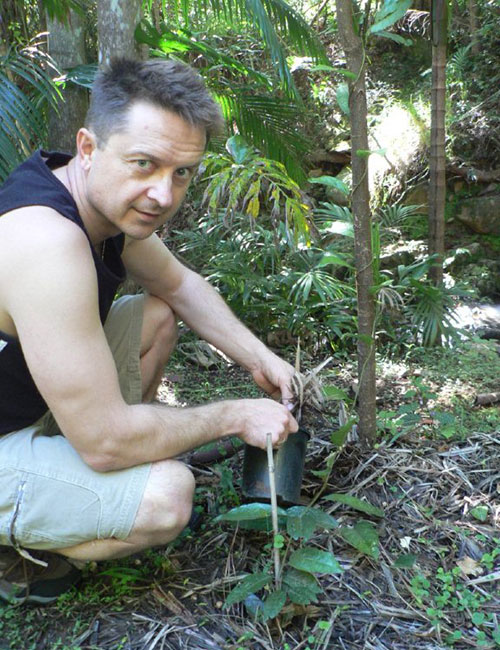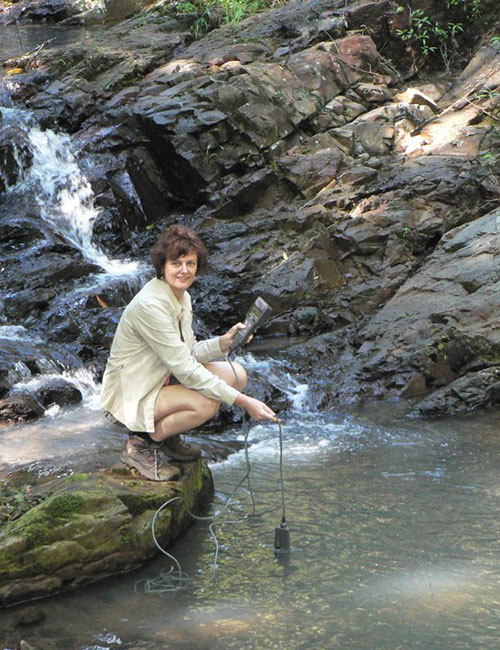Currumbin Valley is the “Green behind the Gold” that many talk about.
Currumbin Creek Road snakes its way through a beautiful sea of green that helps many day trippers unwind. It’s a prescription that many health retreats offer on their menu and it is something well worth maintaining and nurturing for generations to come.
We took that daytrip six years ago and the two inner city Brisbanites fell in love with the natural beauty of the valley. Our 12 acre property is located near the Springbrook National Park (Mount Cougal section) and has its own waterfall in the midst of a rainforest. We simply knew that we had to bring the sparkle back to it.
When we bought the property it had weed infestations that we are still working to control such as coffee trees, Slash Pine, velcro plants (Silver-leaf Desmodium), lantana, bamboo, Camphor Laurel and Mickey Mouse (Ochna). We knew we had to get the property back into its former glory but where does one start?
That is when we turned to Land for Wildlife in order to learn how to manage the weeds. Together with SEQ Catchments, Gold Coast City Council and local bush regeneration contractors, we have learnt how to distinguish the good from the bad. We are also learning how to revegetate, and how to establish quick cover and structure in areas that were not regenerating naturally. These agencies have truly helped us speed up the process of restoration and have helped us developed management plans for the next decade. These plans have incorporated fast-growing pioneer species in our revegetation projects to ensure that conditions are suitable for the recruitment of a more diverse range of plant species. We are also encouraging regeneration on cleared areas of land between patches of rainforest in an attempt to reconnect the rainforest patches. We have planted 1000 trees via the Land for Wildlife program and have recently received a Caring for Our Country grant facilitated by SEQ Catchments. We look forward to seeing how our revegetation projects will change the landscape.
We have had our ups and downs with the process and have learnt that tree guards are a must in this area if you want to keep hungry wallabies from eating new plantings! Let’s face it – we aren’t the only ones that love this valley! We have also been involved in community workshops on other properties in the Currumbin Valley. These have helped us to apply knowledge from others to our property, and have given us direction in the overall management of such a delicate ecosystem.
We have had tremendous success in keeping weeds down to a minimum by utilising techniques learnt from Gold Coast City Council staff including the ‘paint and scrape’ method. Using this technique we don’t disturb the ecosystem in such an abrupt way as opposed to putting a chainsaw into action!
In the 1950s, the property was a banana plantation and employed ‘kanaks’ to help clear and plant bananas. It has been said that the waterfall area, which flows into Currumbin Creek, was where they bathed after a long hard day of toiling. The property then became a coffee plantation and was finally cleared for cattle grazing.
The past has created problems with taro being introduced by the kanaks as a food source and it still grows in areas of Currumbin Creek. We have been managing the waterfall area as a priority in order to eradicate plant species that use waterways to disperse their seeds.
In 2007 when Brisbane was in the middle of a drought, the annual rainfall in this area was 1791 mm. The area has a very high rainfall with the average annual rainfall for the last five years being 2247 mm. This rainfall makes everything grow quickly, including weeds!
Through the SEQ Catchments Water Quality Monitoring program, we have monitored the quality of the water in the creek on our property for the past five years. We have done this using high precision, easy to operate, water quality testing equipment developed by the company HORIBA.
On many journeys to the waterfall area we have encountered many freshwater crayfish, and at different times of the year glow worms, fire flies, yellow-tailed black- cockatoos, brush turkeys, wallabies, noisy pittas, king parrots and snakes.
We have a management plan for the next ten years to get the property back to its former glory and the funding and support that we have encountered along the way has been an enormous help. We are looking forward to the day when we can say our job is done – but that is still a long way down the track!
Article by Nick and Lana Beloff, Land for Wildlife members, Currumbin Valley, Gold Coast

Nick plants another rainforest tree.

Lana monitors the water quality using equipment supplied by the SEQ Catchments Water Quality Monitoring team.
